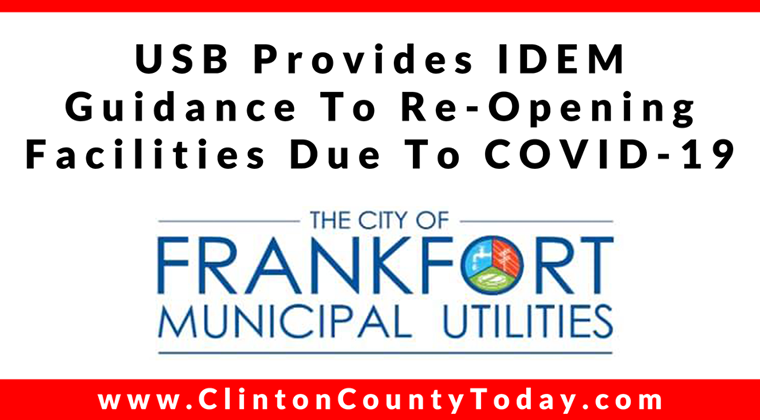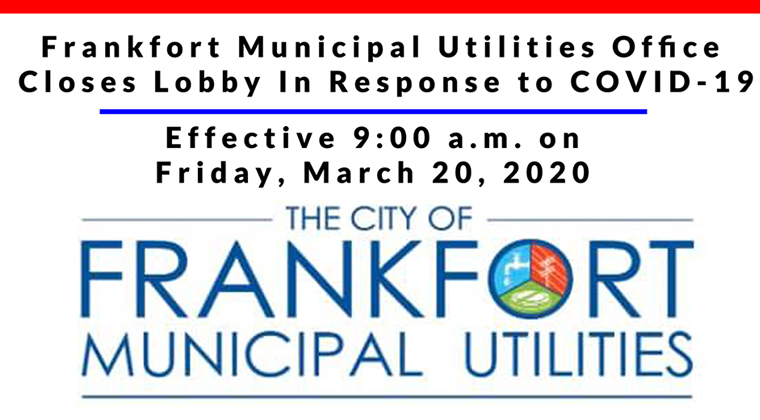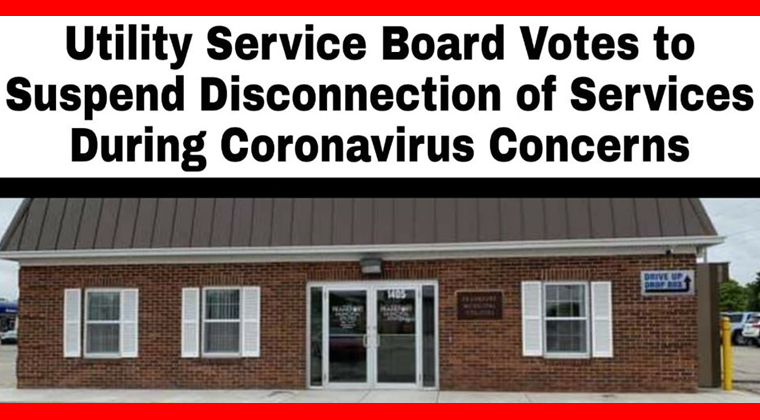Frankfort Utility Service Board Provides IDEM Guidance for Flushing Water Systems
During the Monday, May 4, 2020, USB Meeting, the Indiana Department of Environmental Management guidance to re-opening buildings that may have been temporarily shut down or used less frequently over the last several weeks due to COVID-19 pandemic was shared.
Here is the link to download the complete document in pdf format:
https://www.in.gov/idem/cleanwater/files/dw_guidance_flushing_systems.pdf
Below is the text of the document:
This document is designed to help public water systems prepare their systems for safe use once they reopen buildings that may have been temporarily closed or used less frequently due to the COVID-19 pandemic. It is imperative that operators adhere to the flushing instructions below to ensure their indoor plumbing is receiving fresh water and not stagnant water. The flushing instructions apply to:
• Community water systems such as municipal water supplies, subdivisions, or mobile home parks
• Non-transient non-community water systems such as schools, daycares or factories
• Transient water systems such as churches, restaurants/bars or campgrounds
Issues Caused by Stagnant Water
When water is not used over an extended period, it will become stagnant. Stagnant or standing water can cause conditions that increase the risk for growth and spread of Legionella and other harmful biofilmassociated bacteria. When water is stagnant, hot water temperatures can decrease to the Legionella growth range (77–108°F, 25–42°C). Stagnant water can also lead to low or undetectable levels of disinfectants such as chlorine and could also cause corrosion issues. It is critical to ensure water systems are safe to use after a prolonged shutdown to minimize the risk of Legionnaires’ and other diseases associated with stagnant water.
How to Remove Stagnant Water
Since stagnant water is a potential health risk and can impact water quality, it is necessary to systematically flush the plumbing. In general, flushing involves opening taps and other fixtures and letting water run to remove any stagnant water within plumbing and fixtures. To protect the health and safety of consumers, IDEM recommends that you carefully read and adhere to the following instructions, which provide a systematic approach for conducting a complete flush.
NOTE: Some buildings have water treatment systems and those treatment devices need to be cleaned, flushed, and maintained as part of the start-up process. After flushing, water filters need to be replaced. If there is a point-of-entry water treatment system such as a water softener or filter, please refer to the instruction manual for information on how to replace the filter.
Flushing Instructions
Please complete these steps in the order set out below. Finish each step completely before moving on to the next step. During the initial flushing, it is a good idea to wear protective respiratory equipment. Discoloration and a lingering odor may occur during flushing; these issues are expected and are not a health issue.
1. Flush ALL cold water taps for at least 5 minutes.
Begin the cold water flushing procedure. Open ALL cold-water fixtures and run them for at least 5 minutes. Shut the water off after 5 minutes. Flush each toilet at least one time. This step includes the water in your refrigerator water dispenser.
Flushing should begin at the water service entrance and proceed through the building to the end points of the plumbing system in the building(s). Depending on flow and pressure, you may need to increase the flushing time to ensure all stagnant water has been flushed.
2. Flush ALL hot water taps for 15 minutes.
Once the cold water lines have been flushed, begin the hot water flushing procedure. Open ALL hot water taps in your bathroom(s) including lavatory (sink) fixtures, hot water bath fixtures, and any other hot water fixtures such as kitchens, wet bars, etc. Run these hot water fixtures for at least 15 minutes. Shut the water off after 15 minutes. Depending on the size of the hot water tank, you may need to flush longer to ensure the water in the tank has drained and fresh water has refilled the tank. These steps should be effective at removing contaminants from the water heater. However, for information on draining and cleaning the water heater, please consult the manufacturer.
3. Flush ALL remaining appliances and faucets for 5 minutes.
Open any remaining fixtures such as hose bibs, external faucets, or fixtures not used for drinking for at least 5 minutes to finish the plumbing system flushing. Take additional steps to remove water from other appliances including:
• Ice Makers
• Dishwashers
• Washing Machines
• Humidifiers
• CPAP Machines
• Oral, Medical, or Health Care Devices
• Baby Formula
• Water Filters
• Water Softeners
• Filters (point of use and whole house)
Remove ice from the ice maker bin and discard 2 additional batches of ice. Run empty dishwasher and washing machine once on rinse cycle.
4. Perform periodic ongoing flushes.
Periodic flushing is important to maintain water quality. Full-building, periodic flushes proceed the same as the initial flush except water tanks do not need to be drained and hot water flushing times are the same as cold water flushing times.
If you have chlorinated water, it is a good idea to measure chlorine residual during periodic flushes.
For additional COVID-19 response information that is more detailed, please visit:
https://engineering.purdue.edu/PlumbingSafety/project
Other Resources
• Guidance for Building Water Systems (Centers for Disease Control and Prevention)
https://www.cdc.gov/coronavirus/2019-ncov/php/building-water-system.html
• Return to Service Guidance (American Water Works Association)




